RENAULT FLUENCE 2012 1.G Service Manual
Manufacturer: RENAULT, Model Year: 2012, Model line: FLUENCE, Model: RENAULT FLUENCE 2012 1.GPages: 241, PDF Size: 6.5 MB
Page 41 of 241
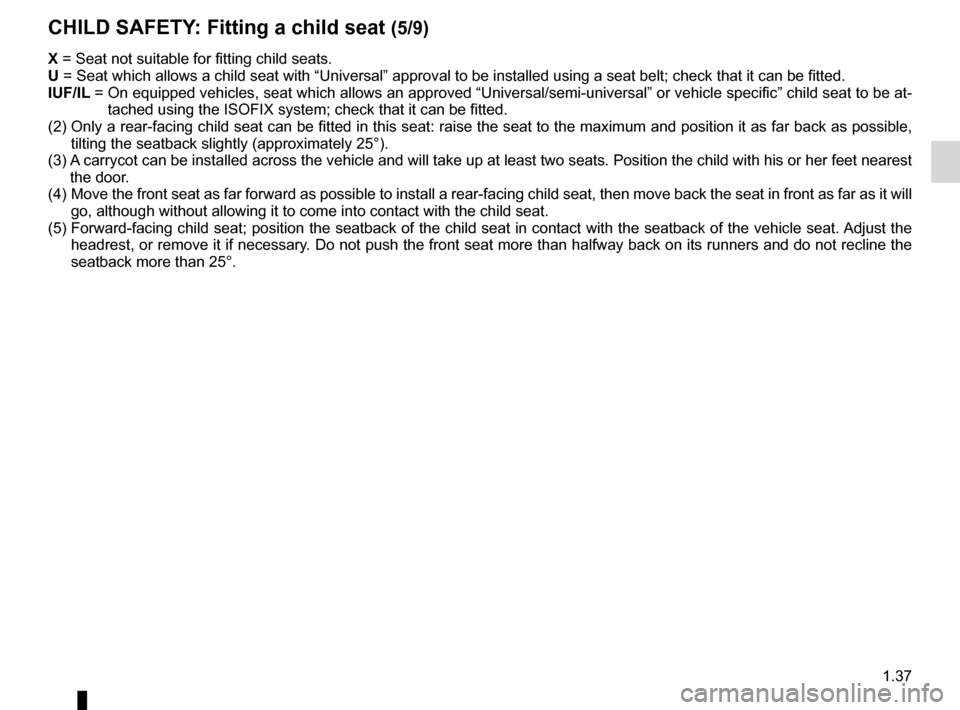
JauneNoirNoir texte
1.37
ENG_UD23757_3
Sécurité enfants : installation du siège enfant (L38 - X38 - R\
enault)
ENG_NU_891_892-7_L38-B32_Renault_1
X = Seat not suitable for fitting child seats.
U = Seat which allows a child seat with “Universal” approval to be ins\
talled using a seat belt; check that it can be fitted.
IUF/IL = On equipped vehicles, seat which allows an approved “Universal/semi-universal” or vehicle specific” child seat to be at-
tached using the ISOFIX system; check that it can be fitted.
(2) Only a rear-facing child seat can be fitted in this seat: raise the seat to the maximum and position it as far back as possible,
tilting the seatback slightly (approximately 25°).
(3) A carrycot can be installed across the vehicle and will take up at least two seats. Position the child with his or her feet nearest
the door.
(4) Move the front seat as far forward as possible to install a rear-facing child seat, then move back the seat in front as far as it will
go, although without allowing it to come into contact with the child sea\
t.
(5) Forward-facing child seat; position the seatback of the child seat in contact with the seatback of the vehicle seat. Adjust the
headrest, or remove it if necessary. Do not push the front seat more than halfway back on its runners and do not recline the
seatback more than 25°.
ChILD sAFETY : Fitting a child seat (5/9)
Page 42 of 241
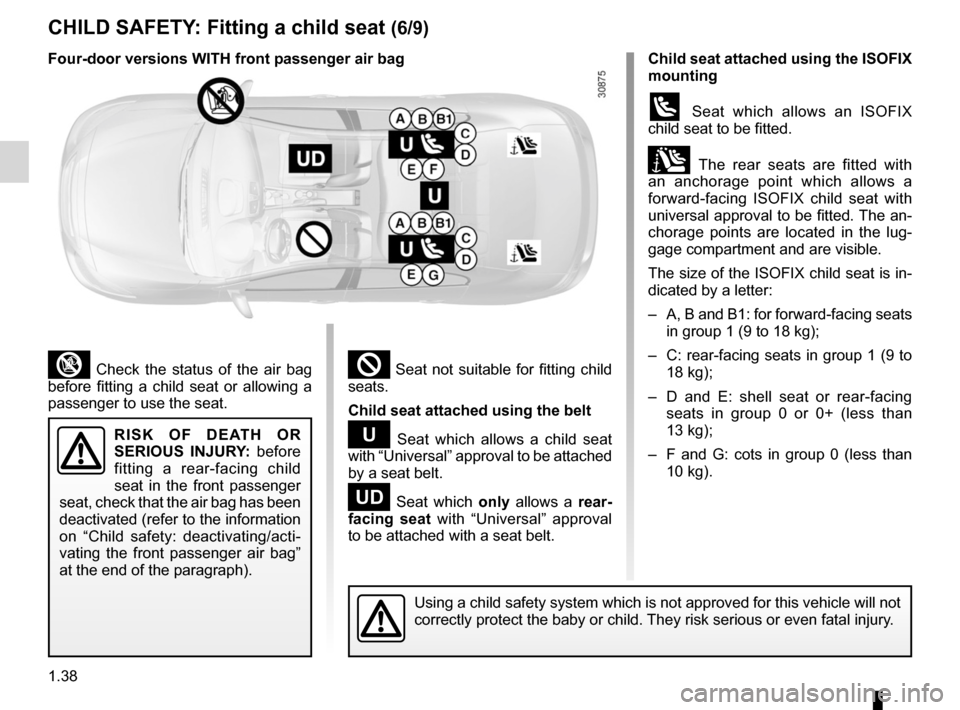
1.38
ENG_UD23757_3
Sécurité enfants : installation du siège enfant (L38 - X38 - R\
enault)
ENG_NU_891_892-7_L38-B32_Renault_1
Jaune NoirNoir texte
² Seat not suitable for fitting child
seats.
Child seat attached using the belt
¬ Seat which allows a child seat
with “Universal” approval to be attached
by a seat belt.
− Seat which only allows a rear-
facing seat with “Universal” approval
to be attached with a seat belt.
³ Check the status of the air bag
before fitting a child seat or allowing a
passenger to use the seat.
R I sK O F D E AT h O R
s ERIOU s INJURY: before
fitting a rear-facing child
seat in the front passenger
seat, check that the air bag has been
deactivated (refer to the information
on “Child safety: deactivating/acti -
vating the front passenger air bag”
at the end of the paragraph).
Child seat attached using the IsOFIX
mounting
ü Seat which allows an ISOFIX
child seat to be fitted.
± The rear seats are fitted with
an anchorage point which allows a
forward-facing ISOFIX child seat with
universal approval to be fitted. The an-
chorage points are located in the lug -
gage compartment and are visible.
The size of the ISOFIX child seat is in-
dicated by a letter:
– A, B and B1: for forward-facing seats
in group 1 (9 to 18 kg);
– C: rear-facing seats in group 1 (9 to
18 kg);
– D and E: shell seat or rear-facing
seats in group 0 or 0+ (less than
13 kg);
– F and G: cots in group 0 (less than
10 kg).
Using a child safety system which is not approved for this vehicle will not
correctly protect the baby or child. They risk serious or even fatal injury.
ChILD sAFETY : Fitting a child seat (6/9)
Four-door versions WITh front passenger air bag
Page 43 of 241
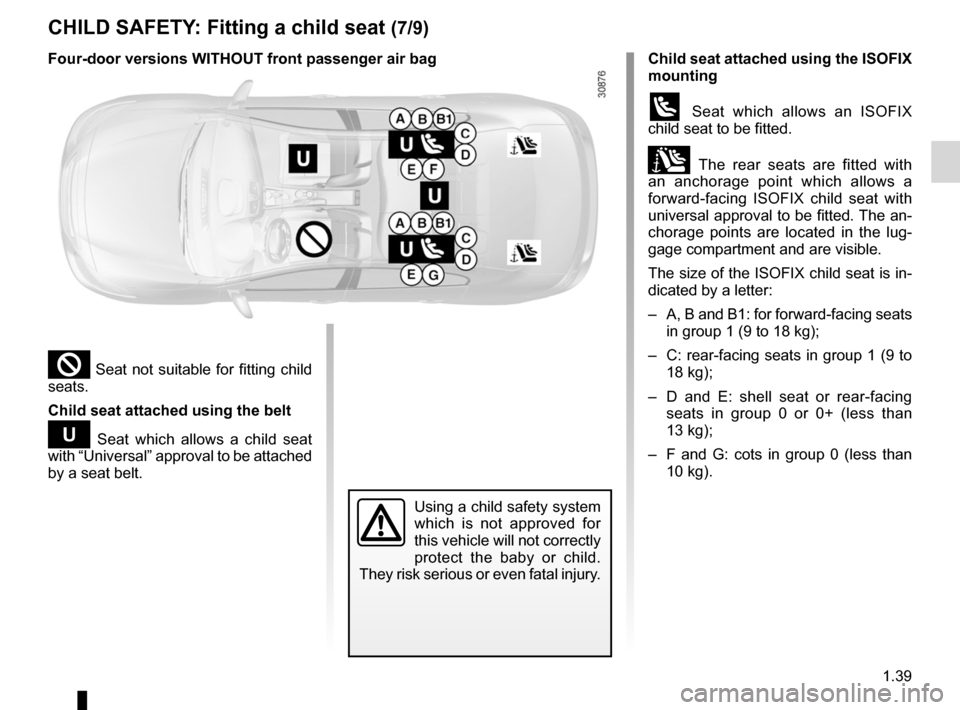
JauneNoirNoir texte
1.39
ENG_UD23757_3
Sécurité enfants : installation du siège enfant (L38 - X38 - R\
enault)
ENG_NU_891_892-7_L38-B32_Renault_1
ChILD sAFETY : Fitting a child seat (7/9)
² Seat not suitable for fitting child
seats.
Child seat attached using the belt
¬ Seat which allows a child seat
with “Universal” approval to be attached
by a seat belt.
Child seat attached using the IsOFIX
mounting
ü Seat which allows an ISOFIX
child seat to be fitted.
± The rear seats are fitted with
an anchorage point which allows a
forward-facing ISOFIX child seat with
universal approval to be fitted. The an-
chorage points are located in the lug -
gage compartment and are visible.
The size of the ISOFIX child seat is in-
dicated by a letter:
– A, B and B1: for forward-facing seats
in group 1 (9 to 18 kg);
– C: rear-facing seats in group 1 (9 to
18 kg);
– D and E: shell seat or rear-facing
seats in group 0 or 0+ (less than
13 kg);
– F and G: cots in group 0 (less than
10 kg).
Using a child safety system
which is not approved for
this vehicle will not correctly
protect the baby or child.
They risk serious or even fatal injury.
Four-door versions WIThOUT front passenger air bag
Page 44 of 241
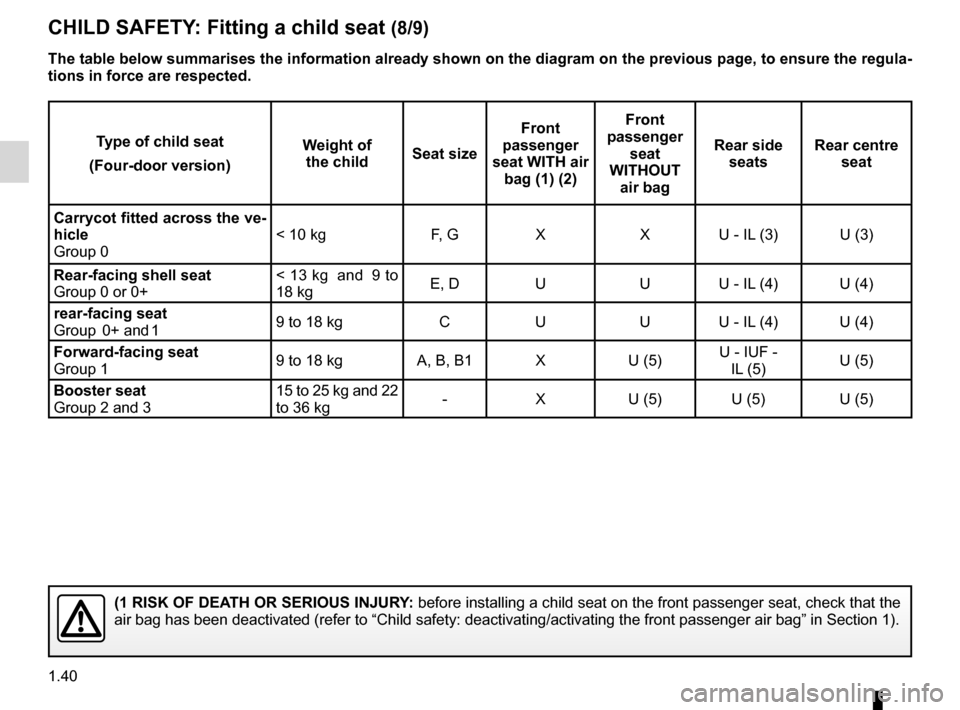
1.40
ENG_UD23757_3
Sécurité enfants : installation du siège enfant (L38 - X38 - R\
enault)
ENG_NU_891_892-7_L38-B32_Renault_1
Jaune NoirNoir texte
ChILD sAFETY : Fitting a child seat (8/9)
The table below summarises the information already shown on the diagram on the previous page, to ensure the regula-
tions in force are respected.
Type of child seat
(Four-door version) Weight of
the child seat size Front
passenger
seat WITh air bag (1) (2) Front
passenger seat
WIThOUT air bag Rear side
seats Rear centre
seat
Carrycot fitted across the ve-
hicle
Group 0 < 10 kg
F, GXXU - IL (3) U (3)
Rear-facing shell seat
Group 0 or 0+ <
13 kg and 9 to
18 kg E, D
UUU - IL (4) U (4)
rear-facing seat
Group 0+ and 1 9 to 18 kg
CU UU - IL (4) U (4)
Forward-facing seat
Group 1 9 to 18 kg
A, B, B1XU (5)U - IUF -
IL (5) U (5)
Booster seat
Group 2 and 3 15 to 25 kg and 22
to 36 kg
-
XU (5) U (5) U (5)
(1 RIsK OF DEATh OR sERIOUs INJURY: before installing a child seat on the front passenger seat, check that the
air bag has been deactivated (refer to “Child safety: deactivating/a\
ctivating the front passenger air bag” in Section 1).
Page 45 of 241
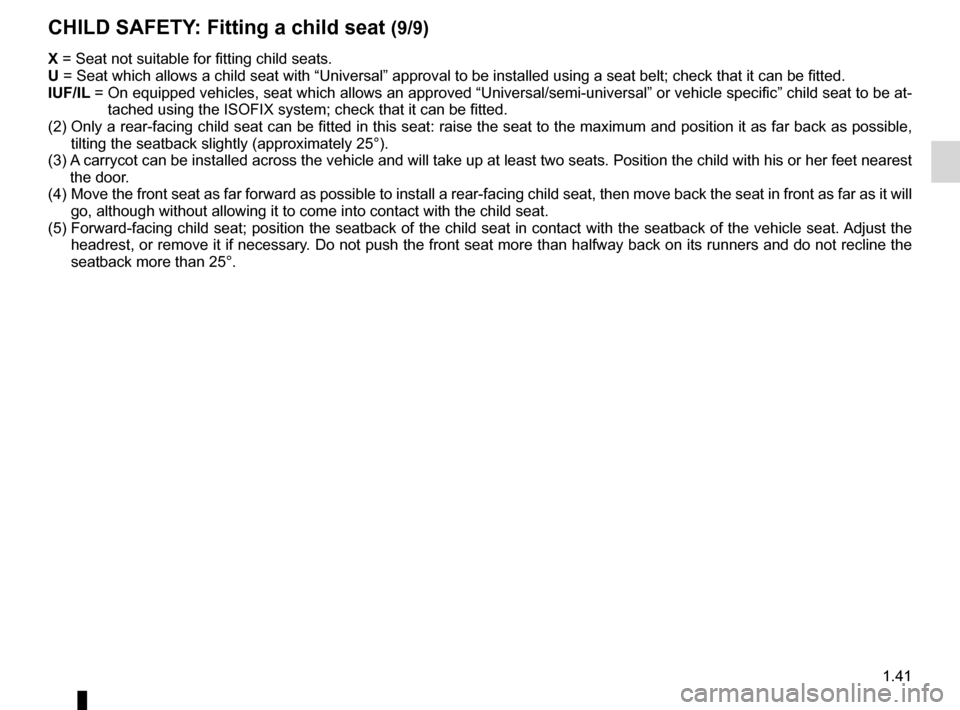
JauneNoirNoir texte
1.41
ENG_UD23757_3
Sécurité enfants : installation du siège enfant (L38 - X38 - R\
enault)
ENG_NU_891_892-7_L38-B32_Renault_1
X = Seat not suitable for fitting child seats.
U = Seat which allows a child seat with “Universal” approval to be ins\
talled using a seat belt; check that it can be fitted.
IUF/IL = On equipped vehicles, seat which allows an approved “Universal/semi-universal” or vehicle specific” child seat to be at-
tached using the ISOFIX system; check that it can be fitted.
(2) Only a rear-facing child seat can be fitted in this seat: raise the seat to the maximum and position it as far back as possible,
tilting the seatback slightly (approximately 25°).
(3) A carrycot can be installed across the vehicle and will take up at least two seats. Position the child with his or her feet nearest
the door.
(4) Move the front seat as far forward as possible to install a rear-facing child seat, then move back the seat in front as far as it will
go, although without allowing it to come into contact with the child sea\
t.
(5) Forward-facing child seat; position the seatback of the child seat in contact with the seatback of the vehicle seat. Adjust the
headrest, or remove it if necessary. Do not push the front seat more than halfway back on its runners and do not recline the
seatback more than 25°.
ChILD sAFETY : Fitting a child seat (9/9)
Page 46 of 241

air bagdeactivating the front passenger air bags ........ (current page)
front passenger air bag deactivation ..................... (current page)
child restraint/seat ................................ (up to the end of the DU)
child safety ............................................ (up to the end of the DU)
child restraint/seat ................................ (up to the end of the DU)
transporting children ............................. (up to the end of the DU)
1.42
ENG_UD17911_3
Sécurité enfants : désactivation/activation airbag passager ava\
nt (L38 - X38 - Renault)
ENG_NU_891_892-7_L38-B32_Renault_1
Jaune NoirNoir texte
deactivating/activating the front passenger air bag
2
Deactivating the front
passenger air bags
(on equipped vehicles)
You must deactivate certain devices
in addition to the front passenger seat
belt before fitting a child seat in the front
passenger seat. To deactivate the air bags: with the
vehicle stationary
, push and turn
lock 1 to the OFF position.
With the ignition on, it is essential to
check that warning light 2
¹ is lit
on the central display and, depend -
ing on the vehicle, that the message
“Passenger airbag off” is displayed.
This light remains permanently lit to
let you know that you can fit a child
seat.
ChILD sAFETY : deactivating/activating the front passenger air bag (1/3)
1
The passenger air bag must
only be deactivated or acti-
vated with the ignition off.
If it is interfered with when
the vehicle is being driven, indicator
lights
å and © will come
on.
Switch the ignition off then on again
to reset the air bag in accordance
with the lock.
Page 47 of 241
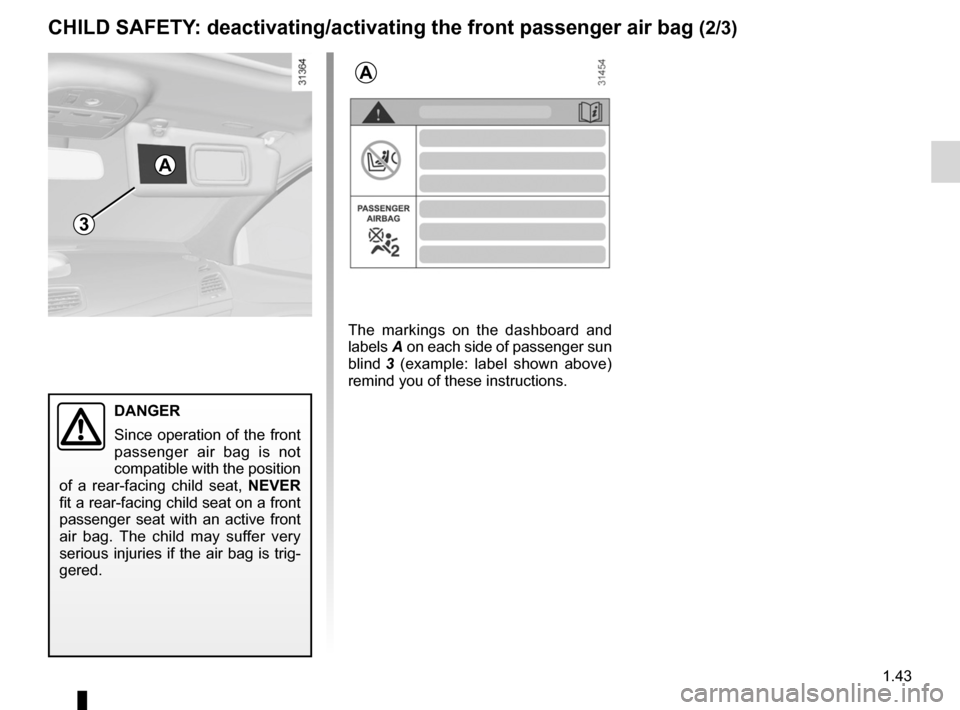
JauneNoirNoir texte
1.43
ENG_UD17911_3
Sécurité enfants : désactivation/activation airbag passager ava\
nt (L38 - X38 - Renault)
ENG_NU_891_892-7_L38-B32_Renault_1
3
ChILD sAFETY : deactivating/activating the front passenger air bag (2/3)
DANgER
Since operation of the front
passenger air bag is not
compatible with the position
of a rear-facing child seat, NEVER
fit a rear-facing child seat on a front
passenger seat with an active front
air bag. The child may suffer very
serious injuries if the air bag is trig-
gered.
The markings on the dashboard and
labels A on each side of passenger sun
blind 3 (example: label shown above)
remind you of these instructions.
A
A
Page 48 of 241
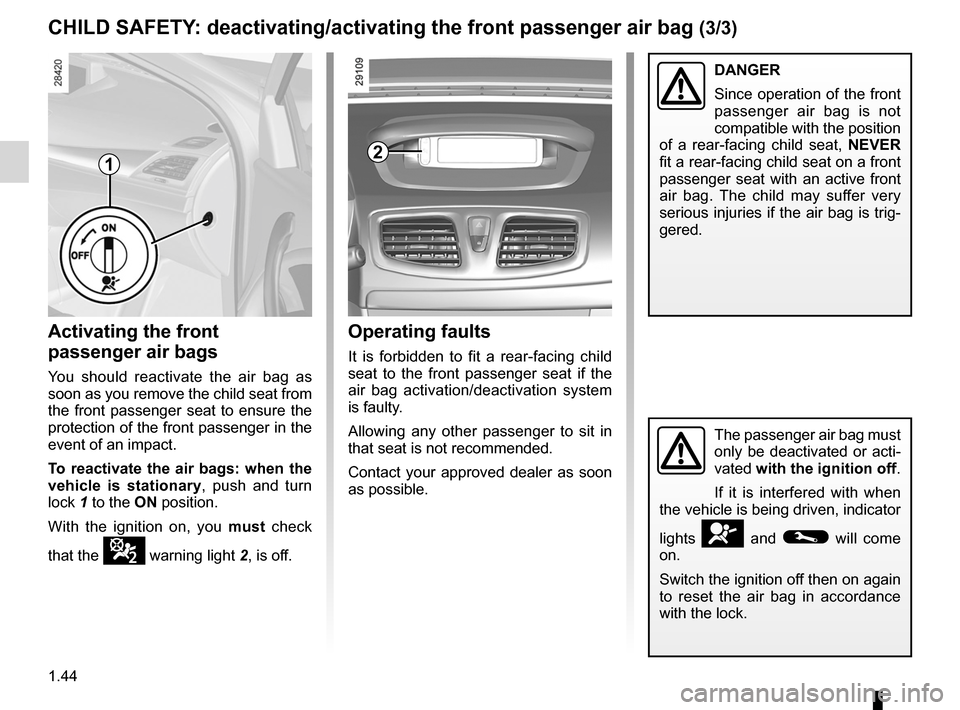
air bagactivating the front passenger air bags ............ (current page)
1.44
ENG_UD17911_3
Sécurité enfants : désactivation/activation airbag passager ava\
nt (L38 - X38 - Renault)
ENG_NU_891_892-7_L38-B32_Renault_1
ChILD sAFETY : deactivating/activating the front passenger air bag (3/3)
2
Operating faults
It is forbidden to fit a rear-facing child
seat to the front passenger seat if the
air bag activation/deactivation system
is faulty.
Allowing any other passenger to sit in
that seat is not recommended.
Contact your approved dealer as soon
as possible.
Activating the front
passenger air bags
You should reactivate the air bag as
soon as you remove the child seat from
the front passenger seat to ensure the
protection of the front passenger in the
event of an impact.
To reactivate the air bags: when the
vehicle is stationary, push and turn
lock 1 to the ON position.
With the ignition on, you must check
that the
¹ warning light 2, is off.
1
The passenger air bag must
only be deactivated or acti-
vated with the ignition off.
If it is interfered with when
the vehicle is being driven, indicator
lights
å and © will come
on.
Switch the ignition off then on again
to reset the air bag in accordance
with the lock.
DANgER
Since operation of the front
passenger air bag is not
compatible with the position
of a rear-facing child seat, NEVER
fit a rear-facing child seat on a front
passenger seat with an active front
air bag. The child may suffer very
serious injuries if the air bag is trig-
gered.
Page 49 of 241

steering wheeladjustment ...................................... (up to the end of the DU)
power-assisted steering ........................(up to the end of the DU)
power-assisted steering ........................(up to the end of the DU)
1.45
ENG_UD18854_2
Volant de direction (L38 - X38 - Renault)
ENG_NU_891_892-7_L38-B32_Renault_1
power-assisted steering
The variable power-assisted steering
system is equipped with an electronic
control system which alters the level of
assistance to suit the vehicle speed.
Steering is made easier during parking
manoeuvres (for added comfort) whilst
the force needed to steer increases
progressively as the speed rises (for
enhanced safety at high speeds).
Steering wheel
Power-assisted steering
sTEERINg WhEEL/pOWER-AssIsTED sTEERINg
steering wheel
Height and, depending on the vehicle,
depth adjustment.
Pull lever 1 and move the steering
wheel to the required position.
Then, push the lever back fully, beyond
the point of resistance to lock the steer-
ing wheel.
Make sure that the steering wheel is
correctly locked.
For safety reasons, only
adjust the steering wheel
when the vehicle is station-
ary.
1
Never switch off the igni -
tion when travelling down -
hill, and avoid doing so in
normal driving (assistance
is not provided).
Never leave the steering wheel on
full lock when the vehicle is station-
ary.
Do not drive with a low battery
charge. The steering wheel may not
operate correctly.
With the engine switched off, or if
there is a system fault, it is still pos-
sible to turn the steering wheel. The
force required will be greater.
A noise may be heard when the
steering wheel is moved quickly.
This is normal.
Page 50 of 241
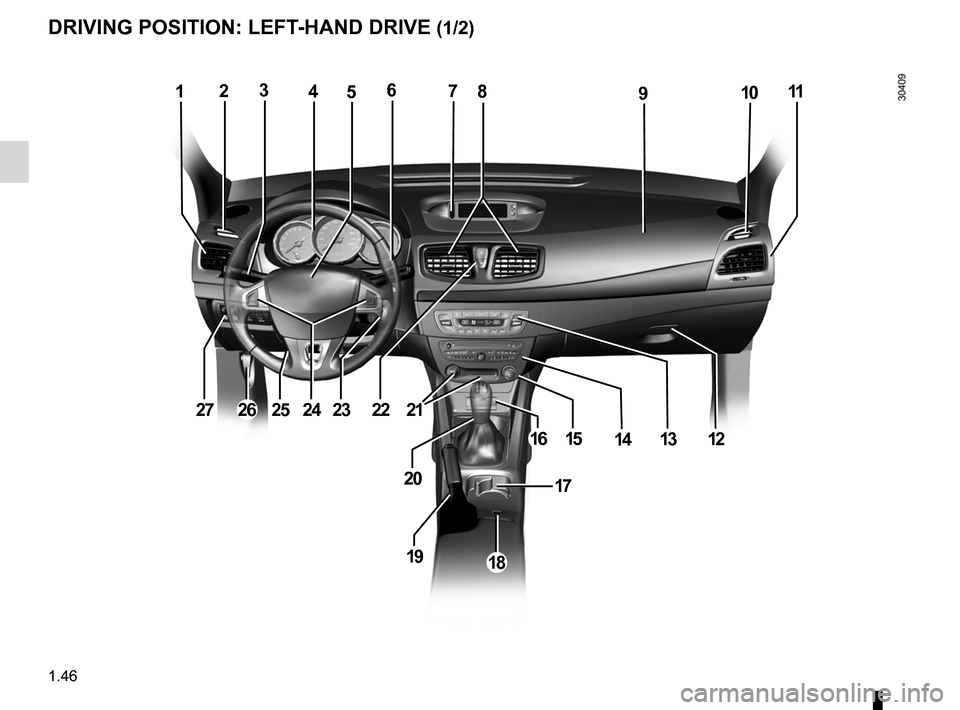
driver’s position .................................... (up to the end of the DU)
controls ................................................. (up to the end of the DU)
dashboard ............................................. (up to the end of the DU)
1.46
ENG_UD13633_1
Poste de conduite direction à gauche (L38 - X38 - Renault)
ENG_NU_891_892-7_L38-B32_Renault_1
Jaune NoirNoir texte
Driving position
DRIVINg pOsITION: LEFT -hAND DRIVE (1/2)
123456891011
12131416
2122
19
15
7
1720
18
2623252427